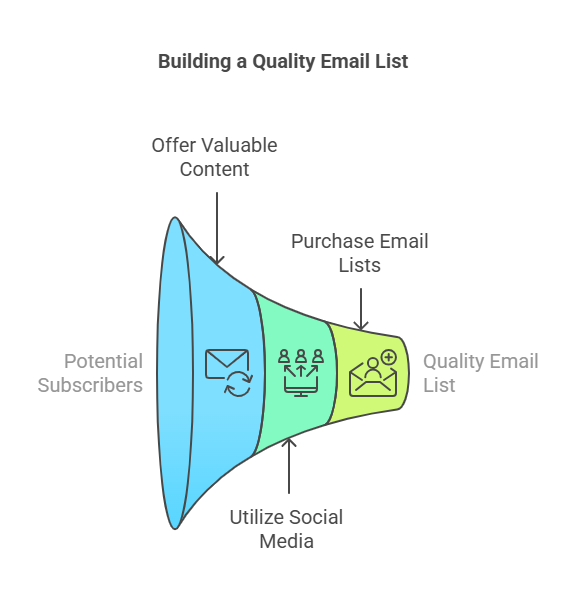Email marketing remains one of the most powerful ways to connect with customers, but it only works if you have the right data. Many businesses struggle with how to get email lists for marketing without falling into the traps of outdated, inaccurate, or non-compliant sources. In this guide, we’ll cover the best ways to build or acquire high-quality email lists that actually deliver results.
The quickest way to start is with a verified B2B email list. Unlike scraped or purchased lists from unreliable sources, LFbbd provides accurate, compliant data that connects you directly with decision-makers.
Why Building an Email List Is Crucial for Your Business?

Building an email list is one of the most valuable strategies for any B2B business. It enables you to stay connected with prospects and clients, fostering long-term relationships that grow over time.
Email marketing allows you to nurture these connections by sending tailored, relevant content directly to their inbox. This personalized communication helps build trust and keeps your business at the top of their minds. 59% of B2B marketers say that email is their most effective channel for generating revenue.
For startups, an email list offers a direct line to potential clients who have shown interest in your services. Unlike social media or paid ads, where visibility depends on algorithms, email marketing puts you in front of your audience whenever you need to be.
Statistics show that email marketing has an average ROI of $42 for every $1 spent, making it one of the most cost-effective methods for lead generation.
While building a high-quality email list takes time, it’s crucial to avoid shortcuts. Purchasing email lists may seem like a quick fix, but the risks far outweigh any potential rewards.
Purchased lists are often full of uninterested or irrelevant contacts, leading to low engagement rates and high unsubscribe numbers. Worse, sending emails to unverified contacts can result in penalties and damage your sender reputation.
The best approach remains gathering emails organically through engaged interactions with your audience.
Effective Ways to Build Your Email List
Building a strong email list requires a blend of strategies that offer value and create a seamless experience for users. Let’s explore some effective ways to do just that.

Offer Value with Lead Magnets
One of the best ways to incentivize users to subscribe to your email list is by offering downloadable resources, such as eBooks, whitepapers, or case studies. These lead magnets provide real value, addressing pain points or offering solutions that are relevant to your audience.
For instance, 80% of B2B marketers use content marketing, and many lead with free resources to attract leads. By giving something valuable in exchange for an email address, you not only grow your list but also build trust and credibility with your prospects.
Create Optimized Signup Forms
Email signup forms should be strategically placed across your website to make it easy for visitors to join your list. Position them on high-traffic pages, such as your homepage, blog, and dedicated landing pages.
Tools like pop-ups or exit-intent popups can further capture attention before a visitor leaves the site. Research shows that pop-up forms can increase conversions by up to 1,000%, making them an essential part of your list-building strategy.
Run Targeted Ads
Paid campaigns on platforms like LinkedIn or Google Ads can help drive targeted traffic to your email signup pages.
By refining your audience based on specific interests, job titles, or industries, you can attract people who are genuinely interested in your products or services.
A study found that LinkedIn Ads can result in 5x more conversions for B2B marketers than other channels, making it an ideal platform for running paid campaigns that lead directly to email signups.
Host Webinars & Virtual Events
Webinars and online events are excellent opportunities to collect emails from interested B2B leads.
By offering valuable insights or showcasing your products through live demonstrations, you can capture the attention of attendees and prompt them to subscribe for future updates.
Webinars have proven to be particularly effective in generating high-quality leads, with 73% of marketers reporting that webinars are one of the most successful methods for converting leads into customers.
Leverage Social Media
Social media platforms like LinkedIn, Twitter, and Facebook offer opportunities to grow your email list by sharing valuable content and promoting lead magnets.
You can also run lead-generation ads directly within these platforms to capture email addresses. LinkedIn’s lead gen forms, for example, streamline the process by allowing users to submit their details with just one click, making it easier for prospects to join your list.
By combining these tactics, you can effectively grow your email list while ensuring the contacts you gather are genuinely interested in your brand. Each method offers a unique approach to attracting prospects, so experiment and find the right mix for your business.
Here’s a table of effective ways to build your email list:
| Strategy | Description |
|---|---|
| Offer Lead Magnets | Provide free resources such as eBooks, whitepapers, templates, or guides in exchange for email sign-ups. |
| Create High-Quality Content | Publish valuable and engaging content on your website or blog that attracts visitors who will want to join your email list. |
| Use Exit-Intent Pop-ups | Trigger pop-ups that appear when visitors are about to leave your site, offering them a special offer or lead magnet in exchange for their email. |
| Run Contests and Giveaways | Organize contests or giveaways where users must enter their email addresses to participate, providing an incentive for sign-up. |
| Offer Discounts or Exclusive Deals | Encourage sign-ups by offering a discount on their first purchase or exclusive access to deals in exchange for their email. |
| Create a Landing Page | Develop dedicated landing pages focused on collecting email addresses by offering something valuable like a free course or resource. |
| Leverage Social Media Platforms | Promote email sign-ups on social media by sharing lead magnets or offering exclusive content only accessible through email. |
| Implement Referral Programs | Offer incentives for current subscribers to refer friends or colleagues to sign up for your email list. |
| Use Content Upgrades | Offer specialized content within your existing blog posts, such as bonus material or templates, in exchange for an email address. |
| Segment Your Audience | Provide targeted opt-in opportunities for specific audience segments, ensuring relevance and encouraging higher sign-up rates. |
Best Practices for Nurturing and Managing Your Email List

Managing and nurturing your email list effectively requires more than just gathering email addresses. It’s about ensuring that the right content reaches the right people at the right time, which ultimately boosts engagement and conversions.
Let’s dive into some best practices for keeping your email list healthy and productive.
Segmentation:
Segmenting your email list is one of the most powerful strategies to ensure your messages are relevant. You can organize your list by industry, job role, or behaviour to send tailored content that resonates with each group.
For instance, a study found that segmented email campaigns can generate 58% of all revenue, showcasing how powerful it is to personalize content.
By segmenting your list, you avoid sending generic messages and instead provide targeted solutions that address the unique needs of each subscriber. This helps increase open rates, click-through rates, and overall engagement.
Provide Valuable Content:
Once you have a segmented list, delivering value becomes key. Focus on providing content that directly addresses your subscribers’ pain points and offers actionable solutions.
This could include industry insights, product updates, or trend reports. Sending informative and helpful content builds trust and positions you as an expert in your field.
Research indicates that 72% of customers say they only engage with personalized messaging, so ensure that your content speaks directly to your subscribers’ interests and challenges.
Drive Traffic to Your Opt-In
- Organic Methods:
- Share your lead magnet on social media platforms like X, LinkedIn, or Instagram.
- Write blog posts or guest articles with a link to your landing page.
- Optimize your site and content for SEO to attract search traffic.
- Paid Methods:
- Run ads on Google, Facebook, or X targeting your audience.
- Partner with influencers or websites in your niche to promote your offer.
Avoid These Common Pitfalls When Building Your Email List
Building an email list can be a game-changer for your business, but you need to be careful to avoid common mistakes that could hinder your success. Let’s dive into the pitfalls you should steer clear of to ensure your efforts pay off in the long run.
Buying Lists
Purchasing email lists may seem like a quick way to boost your numbers, but it’s a tactic you should avoid. These lists are often filled with unqualified leads who have no interest in your products or services.
This leads to low engagement, high unsubscribe rates, and ultimately a poor return on investment. Worse, sending unsolicited emails to people who haven’t opted in puts you at risk of legal issues, especially with regulations like GDPR and CAN-SPAM.
According to the DMA, businesses that engage in cold emailing are at risk of fines that can exceed $20,000 for non-compliance.
Neglecting Permissions
It’s tempting to take shortcuts when building your list, but neglecting to obtain explicit consent from your subscribers is a big mistake.
Always ensure that people have actively opted in to receive emails from you. Not only does this practice help you build trust with your audience, but it also keeps you compliant with data protection laws.
A study by HubSpot found that 78% of people will unsubscribe from a brand if they feel the emails they receive are irrelevant or intrusive. Obtaining proper permissions ensures you’re only reaching individuals who are genuinely interested in your content, leading to better engagement.
Ignoring Analytics
You may be collecting emails, but are you tracking their performance? Without regularly analyzing your email campaigns, you miss valuable opportunities for optimization. Analytics can tell you which subject lines work, what content resonates, and which emails drive the most conversions.
According to Campaign Monitor, email campaigns with optimized subject lines increase open rates by 22%. By tracking metrics like open rates, click-through rates, and conversion rates, you can continuously refine your approach to maximize your email list’s potential.
Avoiding these common pitfalls will help you build a more engaged and compliant email list. By staying focused on quality over quantity, respecting permissions, and using data to guide your decisions, you’ll create an email marketing strategy that drives real results.
Conclusion
Building an email list ethically and effectively is essential for long-term success.
By focusing on strategies like offering valuable lead magnets, creating optimized signup forms, and segmenting your list, you can attract the right audience and drive engagement.
Always ensure that you’re obtaining explicit permission from subscribers to maintain trust and compliance with data protection laws.
Avoid shortcuts like purchasing email lists, which can lead to low engagement and potential legal risks. Track and analyze your email campaigns to continuously improve and optimize your efforts.
A strong, permission-based email list is one of the most effective tools for driving results in B2B companies and startups. It allows you to connect directly with prospects, nurture relationships, and convert leads into loyal customers.

